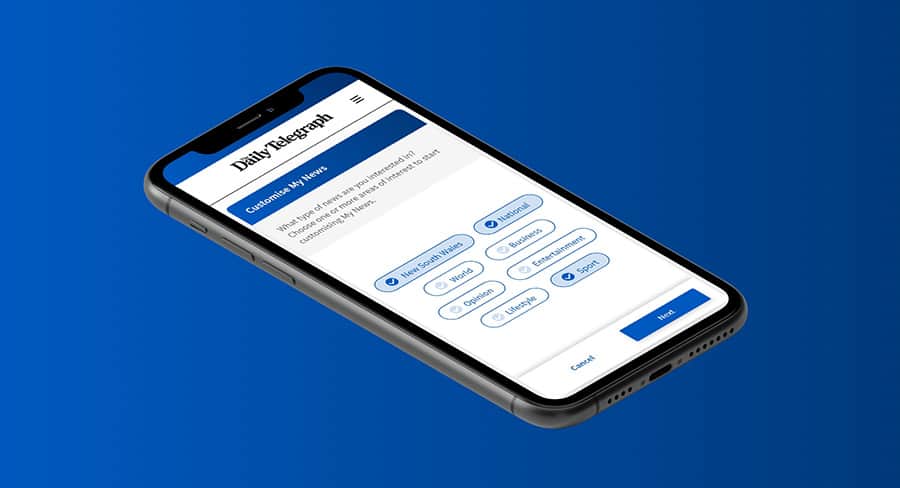News Corp Australia’s state-based mastheads recently unveiled the latest initiative that sees subscribers to its titles around Australia get a new level of control over what they see in their news feeds.
The new personalisation capability is being rolled out across the company’s websites, mobile sites and, in the weeks ahead, the apps of the state-based, regional and community mastheads.
See also: News Corp announces Australia-wide personalised local news content
“We have now rolled out personalisation for the web products – desktop and mobile. The new apps go live later in April,” News Corp Australia’s chief technology officer Julian Delany told Mediaweek.
Just last November, Delany explained to Mediaweek how the publisher was using The Advertiser in Adelaide as the prototype for a major redesign of the digital properties attached to its state-based metro newspapers. The new look was subsequently rolled across digital properties Australia-wide.
See also: News Corp new look: Julian Delany on revamps of digital metro mastheads
The personalisation features can be activated by just a couple of clicks subscribers can make on their homepages.
“You can experience localisation through the postcode widget and personalisation through the news feed,” said Delany.
“These two things are working hand in hand. When I spoke to you in November and I told you about working with consumers and asking them all sorts of questions. There were four big themes that came out.
“The first one was that they wanted to be able to trust these brands.
“The next one was that users wanted a seamless experience across devices from web to app.
“The third theme was discoverability. There is so much content, they want to be able to discover it.
“The last one was personalisation. We linked these last two by creating this technology by letting users control the news they see on their home page. Personalised news and localised news is the way we can do it.
“For example if I am a Herald Sun reader, but I follow the NRL. I can now have NRL news on the home page of the Herald Sun. That hasn’t been possible before.”
The benefits that Delany is describing are available for subscribers on the websites of the cap city mastheads Herald Sun, The Daily Telegraph, The Courier-Mail and The Advertiser.
What about the national daily? “The Australian doesn’t have all this at the moment, but does have some capabilities. It is on our road map to eventually offer this to subscribers of The Australian.”

Personalisation: How it works
Delany: “Underneath the website we have rebuilt all of the code. Our strategy is to have all of our sites on the one codebase so we can mimic different capabilities and get things onto all sites a lot faster. That would mean we don’t have to continually rewrite code for each site.
“This is a real gamechanger in that we have never done anything like this at News Corp. The level of personalisation is very impressive.
“This also enables us to serve up our regional content a lot easier, particularly for regional subscribers. For example, someone living in Coffs Harbour in regional NSW, all of a sudden those subscribers get Coffs Harbour news and Daily Telegraph news all in one spot. That allows us to show off our network.”
Delany noted there is still a lot of curating going on by the publishers, with the top main stories on the site going to all users. “Then people can ask us what the news of the day is according to their preferences and location.”
News alerts
The arrival of Covid has changed the perception of news alerts, with more users now wanting to know when decisions are made that impact their suburbs and states. “We currently can alert subscribers by either a newsletter alert or an alert into their mail inbox. There are also alerts on the apps, but they will be even better when we go live with our new apps.
“We see the alerts as a way of bringing users directly to our brands. Direct traffic is more value than search or social traffic because people are more engaged.”
Importance of newsletters
Delany: “The range of newsletters we publish are now more important than ever. They are a reflection of the brand as well. The newsletters are almost becoming the front page.” Combined, News Corp mastheads sends out a staggering number of newsletters every week.
Consumer-led innovation
“Although it seems obvious, it is worth stressing that all of the tech and product solutions that we have talked about in the past five months all start with the consumer. Although we have done that to an extent in the past, we are really focusing on that now. You can be blinded at times and think you might have nailed something first time, but that is not necessarily always the case.
“This is just the beginning. We will keep pushing our digital product capabilities.”
The publisher engages with consumers via both quant and qual research. “We have increased the amount of qualitative research we have done in the last 12 months. You can misinterpret the way someone answers a question. But during qualitative we can probe why they answer something that way.”
Delany said virtual qualitative research during Covid has made it easier and more cost-effective.
Website redesigns: ‘We got it pretty right’
Regarding the redesign of the various masthead websites at the end of 2020, Delany said: “We got it pretty right. We got some feedback about the amount of sports stories on the home pages. We subsequently added another row of sports stories for people wanting a little more. We realise a lot of our readers still go to the home page to navigate.”
Delany indicated his team review all feedback they get an act according to its merits to make sure the websites can be the best they can possibly be. “We also lifted the font size a small amount after we launched in Adelaide initially. It can be a tricky thing to get right – the size of the front.”
Delany doesn’t want to talk about site relaunches as a “project”. “It is a program of work, it never stops. You can’t launch a site, leave and then do it again in three years. We keep engaging with readers and clients for feedback, continually asking for their opinions.”
